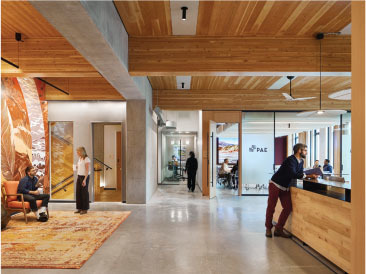December 2013
COMMUNITIES: PRIVATE PRACTICE
For the Client: When Dealing With Disputes, Make Mediation an Option
BY NAHOM GEBRE, ESQ., P.E.
 Mediation is a nonbinding, facilitated process in which an impartial mediator actively assists the parties in identifying and clarifying issues of concern and in designing and agreeing to solutions for those issues. For mediation to work effectively, it is important that the mediator be carefully selected on the basis of qualification, reputation, and knowledge in the design and construction process; that representatives of the parties with authority to resolve the dispute directly and personally participate in the mediation process; and that the parties be willing to participate in good faith in the process and maintain an open mind regarding the issues in question.
Mediation is a nonbinding, facilitated process in which an impartial mediator actively assists the parties in identifying and clarifying issues of concern and in designing and agreeing to solutions for those issues. For mediation to work effectively, it is important that the mediator be carefully selected on the basis of qualification, reputation, and knowledge in the design and construction process; that representatives of the parties with authority to resolve the dispute directly and personally participate in the mediation process; and that the parties be willing to participate in good faith in the process and maintain an open mind regarding the issues in question.
Mediation can proceed under the rules or guidelines of a particular organization, such as the Construction Industry Mediation Rules of the American Arbitration Association (AAA) or the Model Mediation Procedures of the CPR Institute for Dispute Resolution, and the mediator can be selected from that organization’s prequalified panel of mediators. Alternatively, the parties may simply agree on engaging a particular mediator who may establish any necessary ground rules.
Whichever way the parties choose to proceed, mediation is a relatively informal process. Typically, in a given mediation proceeding, the mediator will conduct joint meetings with the parties and separate meetings or caucuses with each party to gain an understanding of the facts and issues involved in the dispute and the underlying concerns and priorities of each of the parties.
During the course of these sessions, the mediator’s objective will be to help the parties identify, clarify, narrow, and ultimately remove the barriers to a mutually satisfactory negotiated settlement. Often, this requires the mediator to serve as an “agent of reality,” by encouraging the parties to consider their individual views and demands more realistically as well as to understand the uncertainty and expense associated with the alternatives to a negotiated settlement—arbitration or litigation.
 Use of mediation can be promoted by including a contract provision requiring the parties to submit disputes to mediation prior to resorting to arbitration or litigation. While mediation is optional under the 2007–08 editions of the Engineers Joint Contract Documents Committee (EJCDC) documents, the 2007 editions of the American Institute of Architects Document A201 and Document B101 require mediation as a condition precedent to arbitration or litigation. The AIA documents further provide that mediation is to be conducted in accordance with the AAA’s Construction Industry Mediation Rules, with the fees split equally between the contracting parties unless they agree otherwise.
Use of mediation can be promoted by including a contract provision requiring the parties to submit disputes to mediation prior to resorting to arbitration or litigation. While mediation is optional under the 2007–08 editions of the Engineers Joint Contract Documents Committee (EJCDC) documents, the 2007 editions of the American Institute of Architects Document A201 and Document B101 require mediation as a condition precedent to arbitration or litigation. The AIA documents further provide that mediation is to be conducted in accordance with the AAA’s Construction Industry Mediation Rules, with the fees split equally between the contracting parties unless they agree otherwise.
A provision based on the EJCDC treatment of dispute resolution would read as follows:
Owner and Engineer agree that they shall first submit any and all unsettled claims, counterclaims, disputes, and other matters in question between them arising out of or relating to this Agreement or the breach thereof (“Disputes”) to mediation by [insert name of mediator, or mediation service]. Owner and Engineer agree to participate in the mediation process in good faith. The process shall be conducted on a confidential basis, and shall be completed within 120 days. If such mediation is unsuccessful in resolving a Dispute, then (1) the parties may mutually agree to a dispute resolution of their choice, or (2) either party may seek to have the Dispute resolved by a court of competent jurisdiction.
Mediation can also be simply described in a contract rather than specifically tied to a set of rules, such as those of the AAA. A simple provision might be worded as follows:
Owner and Engineer agree that if a dispute arises out of or relates to this contract, the parties will attempt to settle the dispute through good faith negotiations. If direct negotiations do not resolve the dispute, the parties agree to endeavor to settle the dispute by mediation prior to the initiation of any legal action, unless delay in initiating legal action would irrevocably prejudice one of the parties.
As a practical matter, the idea of making mediation mandatory is somewhat contrary to its purposes.
However, it provides a valuable opportunity to resolve a dispute in a relatively relaxed, low-key environment. Even if the parties fail to reach a complete resolution of the dispute, they often succeed in narrowing it enough that it can be dealt with more expeditiously in any subsequent adjudicative proceeding. For that very reason, many local courts across the country include a mandatory “mediation track” for certain categories of civil litigation.
The success rate for resolving construction industry disputes through mediation is impressive. Not surprisingly, there is broad support for the use of mediation among professional liability insurers.
Nahom A. Gebre, Esq., P.E., is a risk management attorney for Victor O. Schinnerer & Co. Inc. CNA/Schinnerer’s professional liability insurance program has been commended by NSPE since 1957.


 Volunteering at NSPE is a great opportunity to grow your professional network and connect with other leaders in the field.
Volunteering at NSPE is a great opportunity to grow your professional network and connect with other leaders in the field. The National Society of Professional Engineers (NSPE) encourages you to explore the resources to cast your vote on election day:
The National Society of Professional Engineers (NSPE) encourages you to explore the resources to cast your vote on election day:






